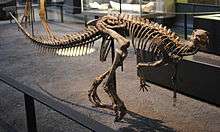1919 in paleontology
| |||
|---|---|---|---|
Paleontology or palaeontology (from Greek: paleo, "ancient"; ontos, "being"; and logos, "knowledge") is the study of prehistoric life forms on Earth through the examination of plant and animal fossils.[1] This includes the study of body fossils, tracks (ichnites), burrows, cast-off parts, fossilised feces (coprolites), palynomorphs and chemical residues. Because humans have encountered fossils for millennia, paleontology has a long history both before and after becoming formalized as a science. This article records significant discoveries and events related to paleontology that occurred or were published in the year 1919.
Expeditions, field work, and fossil discoveries
- Summer: William Edmund Cutler resumed collecting dinosaur fossils in Dinosaur Provincial Park. One discovery was a disarticulated ceratopsian he identified as an "Eoceratops". He spent the remainder of the year excavating the specimen although his progress was hampered by illness and bad weather.[2]
Institutions and organizations
Scientific advances
Vertebrate paleozoology
Data courtesy of George Olshevsky's dinosaur genera list.[3]
| Prehistoric dinosaurs described in 1919 | ||||||||
|---|---|---|---|---|---|---|---|---|
| Name | Status | Authors | Age | Unit | Location | Notes | Images | |
|
Valid taxon. |
|
late Kimmeridgian-Tithonian |
A dryosaurid. |
|||||
| Panoplosaurus[5] | Valid taxon |
middle-late Campanian |
|
|||||
| "Uintasaurus"[6] |
|
late Kimmeridgian-Tithonian |
Junior synonym of Camarasaurus. |
|||||
| Pterosaurs described in 1919 | ||||||||
|---|---|---|---|---|---|---|---|---|
| Name | Status | Authors | Age | Unit | Location | Notes | ||
|
Valid |
von Arthaber |
Whitby Limestone Formation |
A rhamphorhynchid; new genus for "Scaphognathus" purdoni Newton (1888). | |||||
Law and politics
Ethics and practice
People
Awards and recognition
Popular culture
Literature
- In the Morning of Time by Charles G. D. Roberts was published. Paleontologist William A. S. Sarjeant has described it as unusually factual for a work of fiction.[7]
References
- ↑ Gini-Newman, Garfield; Graham, Elizabeth (2001). Echoes from the past: world history to the 16th century. Toronto: McGraw-Hill Ryerson Ltd. ISBN 9780070887398. OCLC 46769716.
- ↑ D. H. Tanke. 2010. Lost in plain sight: rediscovery of William E. Cutler's missing Eoceratops. In M. J. Ryan, B. J. Chinnery-Allgeier, D. A. Eberth (eds.), New Perspectives on Horned Dinosaurs: The Royal Tyrrell Museum Ceratopsian Symposium. Indiana University Press, Bloomington 541-550.
- ↑ Olshevsky, George. "Dinogeorge's Dinosaur Genera List". Retrieved 2008-08-07.
- ↑ Virchow, H. 1919. Atlas and Epistropheus bei den Schildkroten. Sitzungsber. Ges. Naturforsch. Freunde Berlin 1919: pp. 303-332.
- ↑ Lambe, L.M. 1919. Description of a new genus and species (Panoplosaurus mirus) of armored dinosaur from the Belly River Beds of Alberta. Trans. Roy. Soc. Can. (ser. 3) 13: pp. 39-50.
- ↑ Holland, W.J. 1919. Report on Section of Paleontology. Annual Report of the Carnegie Museum (for 1919): p. 38 [and see Holland, W.J. 1924. Description of the type of Uintasaurus douglassi Holland. Annals of the Carnegie Museum 15 (2-3): pp. 119-138.]
- ↑ Sarjeant, W. A. S., 2001, Dinosaurs in fiction: In: Mesozoic Vertebrate Life, edited by Tanke, D. H., and Carpenter, K., Indiana University Press, pp. 504-529.
